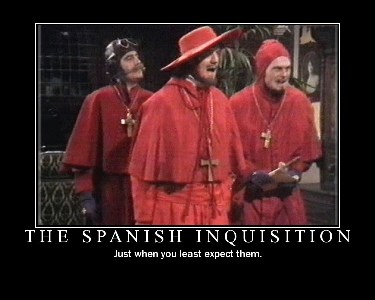THE THEOLOGICAL ENGINEER
The Spanish Inquisition
Faithless Fairy Tales Part 4
By Jeff Laird


The Spanish Inquisition Single Page/Printer Friendly
Continued from Page One

This cannot be excused, but it pales in comparison to the baseless "millions" or "tens of thousands" claims so often used. It's also not that surprising, considering that laws against witchcraft predate Christian missionaries in Europe. For the first few centuries of Christianity, theologians and politicians generally dismissed palpable witchcraft as a superstition, not a threat. Catholicism gradually revived a pagan-style apprehension of witchcraft, particularly in the 15th and 16th centuries. Even then, the Catholic Church actually banned the most famous manual for witch hunters, the Malleus Maleficarum, which persisted anyway as a popular tool of secular witch hunters.
In its 400-year span, the Spanish Inquisition can be firmly blamed for the deaths of as few as 5 people per year, the great majority of those in the first few decades. Upper estimates run to about 5,000 — total, from start to finish. Extreme estimates are still less than 10,000 total, or about 25 per year. Let's be crystal clear: this is nothing to belittle, and just one is one too many. But the truth is, according to both popular opinion of the time, and historical records, the Inquisition was more lenient than the secular courts!
In some instances, the local populace, convinced Inquisitors were not being strict enough, dragged prisoners out of jails and enacted mob justice. It's not a stretch to say the connection to established religion actually made the Inquisition a less violent, more merciful approach to social control than parallel, more secular efforts were. In most regions under its influence, the Spanish Inquisition was hardly a juggernaut of terror.
Accusations of sadism and subterfuge are also historically inaccurate. In most cases, an Inquisition team would enter a town and spend around a month encouraging reaffirmation of orthodoxy. After this, those who refused to cooperate were excommunicated. False accusations were to be expected, though historians acknowledge the Inquisitors followed typical procedures of the era. Convicted heretics were usually assigned penance, which consisted of anything from written confessions, prayer and fasting, or brief imprisonment. More severe offenders, such as those who had become overtly subversive or violent, were imprisoned for longer periods. Some were executed due to particularly severe offenses. Many executions were performed in effigy, where a straw dummy was burnt, rather than the actual person.
Torture is often raised as the higher, more legitimate complaint about the Inquisition. Such methods were used, though — yet again — not as frequently as in purely secular courts. Courts of that era often voiced a verbal threat of torture, called a territio verbalis, which rarely led to physical torture. Actual bodily torture was, indeed, used in a small number of Inquisition cases. Attempts to justify this ring hollow, as they should.
It's clear the Bible offers neither incentive nor approval of torture. For this aspect of the Inquisition, Catholicism, and medieval Christendom, are rightly called on the carpet, with little or no excuse. We've noted the disconnect between Rome and the Spanish Inquisitors, but that disconnect also implies some complacency. When torture was used, it was outside of any acceptable Christian bounds. Logically, though, this means neither the Bible nor Christianity can be held liable for the Inquisition's use of torture. Conduct contrary to the fundamental teachings of Christ can't be blamed on Christ.
It's not unwarranted to place blame on the Catholic Church for the Inquisition itself, for apathy and weakness at the very least, and especially since most of it occurred once the Reformation was well under way. That being said, there are historical reasons to blame Reformers and early Protestantism for the existence of modern Inquisition myths! Some of the earliest exaggerated claims about Inquisitors came from Protestant writers during and after the Reformation, seeking to highlight abuses of Roman Catholicism. Those passed over time from propaganda, into pop culture, into assumed truth. In hindsight, one can see how badly that strategy boomeranged, proving once again that there is no good way, nor any good reason, to deal in exaggeration and falsehood. The ends don't justify the means.
In short, the Spanish Inquisition was un-Biblical, immoral, and primarily secular; a political tool borrowing religious infrastructure. It was not, however, the caricature of Hollywood, late night comedians, and ignorant internet atheists. It simply was not a gory, Bible-driven hurricane of torture and terror; the historical truth is almost mundane by comparison. The methods were typical of the culture, if not a throwback to pre-Christian approaches, and criticized by the public for lenience in comparison to secular courts. The ridiculous body counts and sadistic practices claimed by skeptics are absurd in light of historical data. Records of the time do not indicate widespread horror over the Inquisition, nor do they support the notion of it having primarily religious origins. Violence committed during the Inquisition cannot, and should not, be defended. But all that occurred ought to be put into proper context, and interpreted in a historically meaningful way.

This was the last planned article on common anti-religious historical myths. At some point in the future, however, I may add to the list. Let me know if there's a Faithless Fairy Tale you think should be thrown on the pile!

Faithless Fairy Tales:
Introduction
Part 1: Galileo
Part 2: The Scopes Trial
Part 3: The Crusades
Part 4: The Spanish Inquisition
Image: Monty Python's Spanish Inquisition
Tags: Controversial-Issues | History-Apologetics
comments powered by Disqus
Published 8-13-2014

